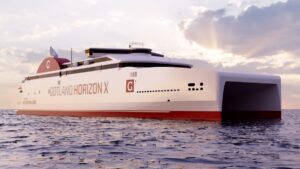Whyalla steel plant owner Sanjeev Gupta has flagged his interest in taking some of the green hydrogen to be produced at the city’s new electrolyser facility, but signalled he will source gas from fossil fuel giant Santos in the interim.
The announcement made on Sunday – effectively an agreement to reach an agreement – is a precursor to talks between Gupta’s GFG Alliance and the state government over volume and price for its landmark green hydrogen plans for Whyalla.
The state government is investing nearly $600 million to build a 250 MW hydrogen electrolyser – to be supplied by wind and solar – and a 200 MW “green hydrogen” power plant to supply the grid in times of peak demand, and low renewables output. The facilities will be the biggest of its kind in the world.
A deal with Gupta would be the first off-take agreement with a third party for the electrolyser, and could be a key part of the billionaire’s plans to make “green iron” and ‘green steel” from the Whyalla plant that he bought out of bankruptcy several years ago.
But the colour of the announcement was tainted by a deal, announced at the same time, of a long term supply agreement with at least partially “abated” gas from Santos, which would make GFG Alliance the first to sign a deal covering its planned $335 million carbon capture and storage project at Moomba.
“Being a key offtaker for the supply of green hydrogen from the world’s largest electrolyser being built in Whyalla is a real privilege for GFG,” Gupta said in a statement.
“This step is vital in our plans to produce premium green iron and steel in Whyalla, and a huge boost to Australia’s determination to lead the world in decarbonisation.”
Gupta says his company plans to produce 4 billion tonnes of high-quality magnetite, and establishment a state-of-the-art green iron and green steel plant which he says will ultimately be powered by renewable energy and green hydrogen.
“These world changing industries will truly put Whyalla on the map, bringing high quality jobs and prosperity to this resilient region, establishing us as a global leader in the production of green iron and steel.”
South Australia already has the highest share of wind and solar in the world for a gigawatt scale grid – averaging more than 71 per cent in the last 12 months and expected to reach “net” 100 per cent in coming years as new wind and solar farms come on line and a new connector is completed to NSW.
However, it will need to build many gigawatts more wind and solar to meet some of the state’s green hydrogen ambitions, which the government is kicking off with its hydrogen plans in Whyalla.
The government on Sunday also announced that global energy giant GE had been selected to provide the aero-derivative turbines for the hydrogen power plant that are capable of operating at 100 per cent hydrogen.
GFG plans to move away from steel made with coal and has signed a contract to install a 1.8 million tonne a year Direct Reduction Plant, which will process local magnetite ore to produce low-carbon iron for use in the electric arc furnace.
This plan will initially use a mix of natural gas and renewable hydrogen sourced from the Hydrogen Jobs Plan facility, before fully transitioning to renewable hydrogen.
“The move to green steel represents a new chapter in Whyalla’s proud steelmaking history, and hydrogen produced at the nearby Hydrogen Jobs Plan facility is poised to play a key role in this transition,” energy minister Tom Koutsantonis said in a statement.
“GFG’s capital investment in this green transformation program is exactly the type of project we hoped to help make possible through our Hydrogen Jobs Plan.”
The announcements were made at the start of a three-day summit on hydrogen and decarbonisation in Whyalla that is looking at using green energy to underwrite the “re-indusstrialisation” of the region.
“South Australia is already further advanced than most other jurisdictions around the world when it comes to decarbonisation,” premier Peter Malinauskas told media at a press briefing in Whyalla on Sunday.
“But the big opportunities in front of us …. are to translate that to re-industrialise,” he said. “We are talking about thousands of jobs … we are standing at the beginning of a really exciting journey ahead.”
Malinauskas says the deal with GFG could involve between 15,000 and 30,000 tonnes, depending on the price negotiated, but Liberty Primary Steel and Mining CEO Sandip Biswas said GFG would likely source a majority gas to ensure the facilities remained competitive.
The switch to blast furnace to electric arc furnace would reduce emissions from around 2kg of Co2 for each kilo of steel, to around 0.6 with gas (presumably abated), and 0.25 to 0.3 with green hydrogen.
Malinauskas also praised Santos for its “world-leading” CCS project, and Santos CEO Kevin Gallagher said GFG Alliance would become the first domestic third-party customer for the company’s flagship CCS project.
Gallagher said the transition to green hydrogen would occur as the technology became more available, and more affordable, “in the years ahead”. He said the Moomba CCS project was 80 per cent complete and would come on line in the middle of the year.
“We can help them transition over the next few decades,” Gallagher said. RenewEconomy reached out to Santos to ask how much of the gas production would be abated by the CCS project. We have not yet had a reply.










